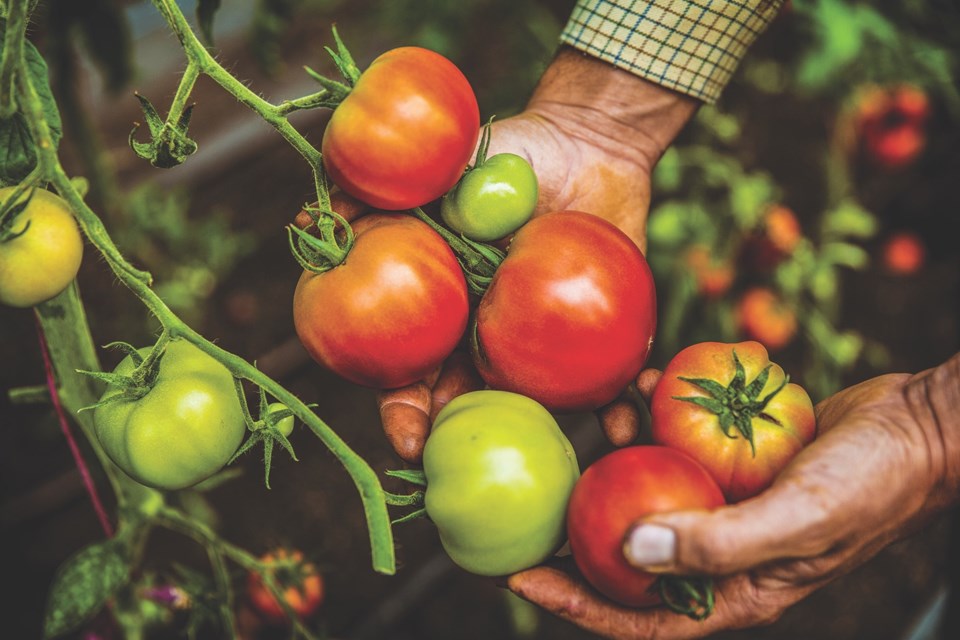While we may complain about the heat, the hot weather vegetables love it: beans, corn, cucumbers, peppers, tomatoes, squash, and pumpkin.
All need a fertile soil, well-amended with compost. Place these where they get at least six hours of daily sunlight. Once the plants get six inches tall, mulch. Except for beans and corn, water the roots by placing tin cans with holes in the bottom, set flush in the soil by each plant. Mulch once the plants reach six inches tall.
Plant beans, corn, squash, and cucumbers directly in your garden around the third week of May, following the instructions on the seed package regarding seed spacing. Keep the surface moist until the seeds sprout. Check the long-range weather forecast and be prepared to cover them if frost is predicted. Inspect every few days for mould, pests, and slugs.
Beans come as bush or pole types. Pole beans produce up to three times the amount of beans per area of garden as compared to the bush bean. Harvest when the seeds in the pods are small. Beans produce more if picked regularly. If you want dried beans, let them grow and dry on the plant.
Corn matures in up to 90 days, and may not develop if August is cool. Plant an early maturing variety in early May, but be prepared to cover the seedlings in case of frost. Plant corn in at least four-foot-wide squares. Why? Corn is wind pollinated; at the end of each cob is a cluster of hairs attached to a kernel in the cob. Wind distributes pollen from hair to hair, thus pollinating the kernels. Pick corn when the silk turns brown.
Cucumbers grow best up a trellis. You will have to nudge the plants to the trellis and tie them to the trellis. Pick cucumbers before they get too large, before they start to turn yellow and bitter. The more you pick, the more the plant produces.
Squash: Pumpkin and winter squash are vines. Plant in mounds four feet apart. Add nitrogen fertilizer, blood meal, when starting to grow, and again when they start to blossom. The male flowers are first to flower. Female flowers have a swelling at the base of the flower, and appear a week or two later. Gold Nugget, a bush squash, yields about 10 soft-ball-size squash per plant.
Pick zucchini up to eight inches long. The more you pick, the more the plant produces.
Tomatoes and peppers are self-pollinating; each flower has both male and female parts. Pepper and tomatoes seedlings are best started around April 15. If you purchase seedlings from a market garden, don’t buy plants that are blossoming or have tomatoes or peppers already set.
Transplant the seedlings in the third week of May, depending on frost warnings. Before transplanting, mix a handful of crushed egg shells and a couple of tablespoons of bone meal in the transplant hole, water, then transplant. Be prepared to cover them in case of frost.
Peppers do not need nitrogen fertilizer; the result will be great foliage, but little fruit. Harvest green peppers when they reach a reasonable size. Leave them longer and they will turn red and sweeter. But, the more you pick, the more the plant produces.
Tomatoes are either indeterminate or determinate, vine or bush. Transplant the seedlings about 18 inches apart with the first set of leaves at ground level. The eggshells and bone meal and regular watering should eliminate blossom end rot.
The indeterminate tomatoes must be staked and can grow up to seven feet. The determinates can be planted in the garden or in large containers, unstaked.
Prune indeterminates regularly, removing most laterals so the plant can concentrate on the fruit and not on the leaves. Little pruning is needed for the determinate or bush types.
Pick tomatoes when they change colour, or are soft to the touch when you squeeze them.
https://learningbygrowing.com/the-hot-weather-vegetables/
Charles Schroder gardens in the Edmonton area.




